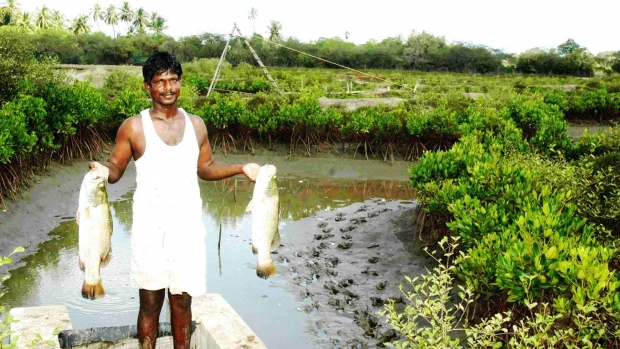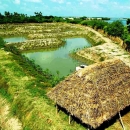Grants :: Small Grant Facilities :: Sustainable coastal livelihoods through Integrated Mangrove Fishery Farming Systems (IMFFS)
Sustainable coastal livelihoods through Integrated Mangrove Fishery Farming Systems (IMFFS)

Sea bass harvested from IMFFS farm, Tamil Nadu, India © MSSRF, 2007
Objectives
This project sought to create awareness among local communities and other stakeholders of the need for alternative or additional income-generating activities based on natural resources, and to demonstrate a brackish water and mangrove-based farming system for wider replication. Also a priority was enhancing the capacity of women, local NGOs and government agencies for developing integrated mangrove fisheries.
Background
Chemically intensive, environmentally damaging coastal prawn farming was popular in India during the early 1990s. However, monocultures, disease, poor seed quality, excessive use of artificial feed, poor environmental management, increased input costs and decreased market returns contributed to a wide-scale collapse of aquaculture production. Consequently large areas of coastal land, too saline to be returned to their original agricultural use, were abandoned and local farmers and land owners left destitute. The project recognized the pressing need to return these lands to productivity, and in response designed an integrated mangrove fishery farming system to support the development and demonstration of aquaculture systems in community mangroves that integrate livelihood security with ecological security.
Target beneficiaries
Prawn farmers (land owners) and local communities.
Outputs
- Two different models of IMFFS were developed and demonstrated in abandoned prawn farms.
- Ninety-four women, men and youth from coastal communities, as well as 21 managerial field staff from state and central government agencies, took part in orientation and exposure visits to IMFFS sites and learned about the IMFFS protocol.
- Commercially important fish such as sea bass and mullet were successfully grown and harvested in the integrated mangrove farms.
- Preparation has begun of manuals in local languages describing methods for replicating IMFFS.
Accomplishments and challenges
The IMFFS farms work on the principles of ecological and environmental sustainability. They are fed by tidal water, making pumps unnecessary. Tidal flows also bring in natural feeds and new fish and prawn seed, and flush away wastes.
Both IMFFS models had a very high mangrove survival rate (92%). Also encouraging were survival rates for introduced tiger prawn seed and mullet and sea bass fingerlings (60%). In all, 94 community members (including 36 women), and 21 state and central government staff, developed their capacity for IMFFS through workshops and exposure visits. The project successfully overturned the negative local perception of aquaculture caused by the industry’s collapse in the 1990s. The Aquaculture Authority of India is exploring the possibility of eco-labelling IMFFS products.
Challenges
One issue faced by the project was the need to document fully the economic returns from IMFFS to support replication and scaling-up. The impacts of climate change on the coast are a growing challenge. It is hoped that the mangroves will help protect the IMFFS ponds from extreme weather events.
Contributions to cross-cutting themes
Communications
The project produced a training manual on IMFFS methods for communities interested in replicating the field models.
Gender equality
Alternative livelihoods for women were created through the provision and operation of air-conditioned market stalls (to extend the shelf life of fish and other marine products), and the production of organic fertilizer using waste and dead fish from the IMFFS ponds. Thirty-six women attended workshops on project procedures and products, and joined site visits. If the IMFFS methods are adopted by local communities, both men and women will benefit from the new livelihood opportunities they offer.
Climate change
The predicted increase in terrestrial salinity from rising sea levels will lead to changes in land use. IMFFS will help compensate for any agricultural land lost in this process, thus enhancing the capacity of coastal communities to adapt to climate change.
Lessons Learned
Project designs have to be adaptable. In the case of IMFFS, project partners did not anticipate that training facilities and manuals would be needed to satisfy the high level of popular interest.
It is important to consider the future impacts of project activities. Although IMFFS relies on natural tide-borne feed, making artificial feed unnecessary and so contributing to water clarity, growing mangrove plantations can eventually degrade water quality by causing dead plant matter to accumulate in the ponds. Long-term monitoring is needed to understand the scale of this threat. In this respect, it is encouraging to note that both the M. S. Swaminathan Research Foundation and the land owner (SSS Marine Farms) continue to develop IMFFS with other funding and are addressing these monitoring needs.
Project Facts
Country
Location
Tamil Nadu, India
Topic
- Strategies for Management
- Civil Society Engagement
- Community Resilence
- Gender equality
- Climate change
- Knowledge management and communications
Duration
6th Jan 2009 to 31st Oct 2009
MFF Grant Amount
US$21,000
Implementing Partner
Dr V. Selvam
Director
M. S. Swaminathan Research Foundation
111 Cross Street, Taramani Institutional
Area, Taramani, Chennai 600 113, India
Email: vselvam45@hotmail.com
Related Events
Sharing Lessons on Mangrove Restoration - MFF Regional Colloquium
Mamallapuram, near Chennai (Tamil Nadu), India 30 Aug - 31 Aug 2012
A regional colloquium on sharing lessons in mangrove restoration on August 30-31, 2012 in Chennai, India examines the various experiences from MFF countries where mangrove projects have been carried out. The colloquium ...


